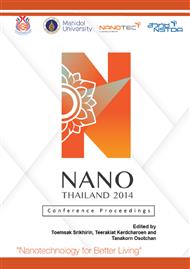p.146
p.153
p.157
p.165
p.169
p.175
p.182
p.186
p.193
Correlation between Conversion Efficiency and Impedance Spectroscopy Parameters for Dye Sensitized Solar Cell with TiO2 Nanostructure Modification
Abstract:
Impedance spectroscopy (IS) is a useful technique to investigate the detail of charge transfer in dye sensitized solar cell (DSSC) especially for individual part of cell component. The charge transport in electrolyte, platinum and TiO2 electrodes can be separately examined by varying the frequency range of IS. In this work, the TiO2 electrode was modified by various nanostructures and the equivalence circuit parameters extracted from the measured IS were correlated to the power conversion efficiency of fabricated solar cells, in order to describe the origin of decreasing and increasing of the DSSC efficiency. The TiO2 electrode was prepared at different conditions of mixing with inorganic nanoparticle of CdS, CdSe and nanostructure of C60 at various concentration. Normally, the DSSC with unmodified TiO2 electrode shows the efficiency about 7.12% at AM 1.5. The dramatically dropping of efficiency was occurred in the cell with very small amount of nanoparticle added in TiO2 electrode. For most of the cases, the efficiency tended to become increase as increasing the amount of nanoparticle in the TiO2 electrode. In some structures, the efficiency can become higher than that of the unmodified TiO2 cell. However the large amount of nanoparticle in TiO2 electrode leaded to decreasing of cell efficiency in all fabricated types of TiO2 nanostructure. These efficiency variations were related to the resistance and capacitance values extracted from IS measurement in the frequency range of TiO2 response. It was found that the extracted value of cell resistance played the important role on the efficiency variation and the capacitance value can be used to describe the life-time of charge carrier in the cells.Keywords: Impedance spectroscopy, dye sensitized solar cell.
Info:
Periodical:
Pages:
169-174
Citation:
Online since:
December 2015
Keywords:
Price:
Сopyright:
© 2016 Trans Tech Publications Ltd. All Rights Reserved
Share:
Citation:


